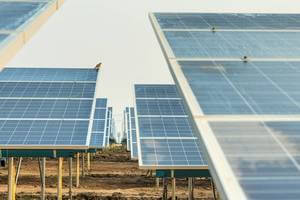This article presents the best bird control systems to prevent birds from nesting under solar panels on residential rooftops. It also discusses how to repel birds from solar farms and parks, which often occupy large areas of land, ranging from one to several hectares.
But first, let’s review some important concepts about:
- Thermal and photovoltaic solar energy.
- Difference between solar installations used for domestic and commercial purposes.
- How to perform maintenance of solar panels and photovoltaics, avoiding one of the main problems: bird droppings.
Solar Energy
The sun is the primary source of energy on the planet. Solar photovoltaic energy is the transformation of sunlight (solar energy) into electricity (electrical energy) through photovoltaic panels, or PV (Photo Voltaic) panels. Solar thermal energy, or thermosolar energy, uses solar thermal panels to produce heat that can be used, for example, to heat domestic water or provide heating for a residence.
In Spain, we have been involved in the installation of solar panels and photovoltaic panels for years, and we are a pioneering country in the development of these energies.
Difference between Solar Farms and Solar Parks
Solar panels can be installed on residential rooftops for domestic use, or they can be placed on the ground in what are known as solar farms, solar fields, or solar orchards. A solar farm typically occupies one hectare of land and can provide energy for the consumption of 100 households.
On a commercial scale, there are solar parks, which are much larger than a solar farm. Solar parks are also referred to as solar power plants. Within solar power plants, there are two types: solar thermal power plants and photovoltaic power plants, depending on whether they produce thermal solar energy (heat) or photovoltaic energy (electricity).
Maintenance of Photovoltaic Panels and Solar Panels
With proper maintenance, solar panels can easily reach a lifespan of 30 years. The maintenance of a solar panel is straightforward, and cleanliness is essential.
Solar panels must be completely clean to receive sunlight effectively and produce their maximum energy output. A dirty solar panel can produce between 15% and 30% less energy and reduce its lifespan.
Other aspects to consider in solar panel maintenance include the condition of the insulation and wiring that conducts the electricity generated by the panel to the grid, as well as the overall condition of the installation, avoiding corrosion, oxidation, scratches on the panels, etc.
Why do solar panels get dirty?

The main elements that cause dirt on solar panels, leading to a decrease in performance and a reduction in lifespan, are dust, ice, leaves, and most importantly, bird droppings.
If a solar panel is covered in bird droppings, it needs to be properly cleaned. These droppings block sunlight, are corrosive, and will not wash away with rain alone.
To clean solar panels, you can simply use water or a glass cleaner with a soft cloth or sponge. The key is to clean the panel with a damp cloth that removes dirt without scratching the surface, which could reduce its productivity.
If the bird problem persists, it will be necessary to implement a bird control system that permanently keeps birds away from the solar installation.
There are different bird control systems for solar panels depending on the type of solar installation:
- Bird control systems for solar panels in residential settings, installed on the rooftops of buildings
- Bird control systems for solar panels or photovoltaics in commercial scale, installed in farms, fields, orchards, or solar power plants
In residential settings, how to prevent pigeons and other birds from nesting under rooftop solar panels?

In many urban areas, pigeons have found the space between solar panels and the rooftop to be the perfect spot for nesting. They can enter and exit freely, protected from predators and adverse weather conditions such as rain, snow, cold, or high temperatures.
There are different solutions to prevent birds from nesting under solar panels:
- AviFin Gel
- BirdBlocker – Anti-Bird Netting
- Bird Repellers by Sound
- Bird Visual Repellers
- Spikes
AviFin Bird Control Gel
The AviFin Bird Control Gel provides effective results in preventing birds from accessing the area beneath solar panels.
- This gel is a brownish-yellow silicone compound made from natural extracts and essences.
- It is necessary to apply multiple lines of the product around the perimeter of the solar panel so that birds cannot jump over the AviFin Gel when trying to access the area beneath the panels.
- The product’s durability outdoors is around 2-4 years.
- One tube of AviFin Gel covers approximately 8 – 10 linear meters.
- To apply the AviFin Gel, a silicone gun is needed.
BirdBlocker – Anti-Bird Netting
Another more powerful solution to prevent pigeons and other birds from nesting under rooftop solar panels is to install BirdBlocker, a physical barrier that prevent birds from accessing these spaces.
These physical barriers consist of bird netting, which is attached to the perimeter of the solar panel using clips. These clips do not require drilling and do not scratch or damage the integrity of the panels. The netting is practically invisible once installed.
Sonic Bird Repellers
The Bird Gard Pro bird repeller is also effective in deterring pigeons and other birds, preventing pigeons from nesting under the panels.
However, since this bird repeller operates by emitting audible sounds, it may not be suitable for residential buildings due to the potential disturbance caused by the sounds to the building occupants.
Visual Bird Repellers
There are different types of visual bird repellers, including scarecrow kites that simulate the presence of a hawk in the area, scarecrow balloons, plastic eagles, replica owl scarecrows, etc.
To achieve greater effectiveness, it is important that visual bird repellents are not static (plastic figures are not effective). It is also advisable to change their position periodically to prevent birds from getting used to their presence.
Visual bird repellents are often used as a complement to other bird control measures.
Spikes
We do not recommend installing bird spikes on solar panels. These bird spikes are usually placed on the edges of the panels to prevent pigeons from perching on those specific areas covered by the spikes. However, they do not provide protection to the rest of the installation or prevent pigeons from nesting under the panels.
On a commercial scale, how to prevent birds and their droppings in solar farms, fields, and solar parks?

A solar farm or solar orchard usually covers about one hectare of land. Solar parks or solar fields are much larger, spanning several hectares.
To prevent bird damage in these solar installations, the most suitable bird control system is the Bird Gard sonic bird repeller. The advantage of this bird control system is its effectiveness in permanently deterring birds, and one single device can cover up to 12 hectares of land.
The Bird Gard sonic bird repeller is being used with excellent results to protect numerous solar and photovoltaic installations. A recent example can be found in Italy, where the installer of photovoltaic systems, Tesla Saver Energy, uses it in several solar parks to ensure proper maintenance of the installations and prevent seagulls and pigeons from leaving droppings on the panels.
If you want to achieve maximum performance from your solar or photovoltaic installation by deterring birds with the Bird Gard sonic repeller, visit the online store of BirdGard Iberia and conveniently purchase your electronic scarecrow.





